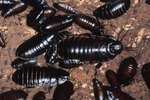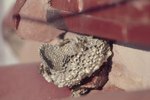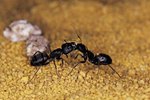
Although the vast majority of cockroach species live in the wild and aren’t pests to human settlements, those that do enter our homes bring with them a range of unwelcome accompaniments. They are vectors for disease, they trigger allergies, they poop and, frankly, they stink. Since they’re nocturnal, it's often the smell of roaches that first alerts a home or business owner that they’ve got a roach problem.
Signs of Infestation
Take a single cockroach in your hand and, with most pest species, the scent will be almost undetectable. However, in sufficient numbers the faint, oily musk of each roach combines to create a distinctive and sometimes overpowering odor. When roaches swarm, they each give off a pheromone in order to let other roaches know they’ve found a good place to nest. When concentrated, this pheromone is easily detectable to the human nose.
Deliberate Secretions
While most species of roaches only stink when in sufficient numbers, a single German cockroach (Blatella germanica) is capable of offending the nostrils on his own. These roaches, common to homes in Europe and the United States, deliberately emit a nasty pong as part of their daily routine. This odor, even without contact, can affect the flavor of food and may hang around for some time after the roach or roach swarm has been dealt with.
Stench of Death
A study conducted at McMaster University, near Hamilton, Ontario, found that certain insects, including cockroaches, emit a specific death stench. This stench is caused by oleic acid, which is produced by the decomposing body. This “death recognition system,” likely an evolutionary adaptation developed 400 million years ago, enables cockroaches to avoid places and spaces where there is a threat to life, such as predators or a virus.
Sexy Scent
As well as warning their own kind of a threat to life, cockroaches use scent to attract mates. A study conducted at North Carolina State University found that when they synthesized the chemicals emitted by females looking to mate, they could attract swarms of males. As a cockroach control technique, this is potentially more effective than using traps and insecticide combined, as it draws high volumes of roaches to the same spot.
References
Photo Credits
-
Jupiterimages/Photos.com/Getty Images
Writer Bio
Simon Foden has been a freelance writer and editor since 1999. He began his writing career after graduating with a Bachelors of Arts degree in music from Salford University. He has contributed to and written for various magazines including "K9 Magazine" and "Pet Friendly Magazine." He has also written for Dogmagazine.net.




